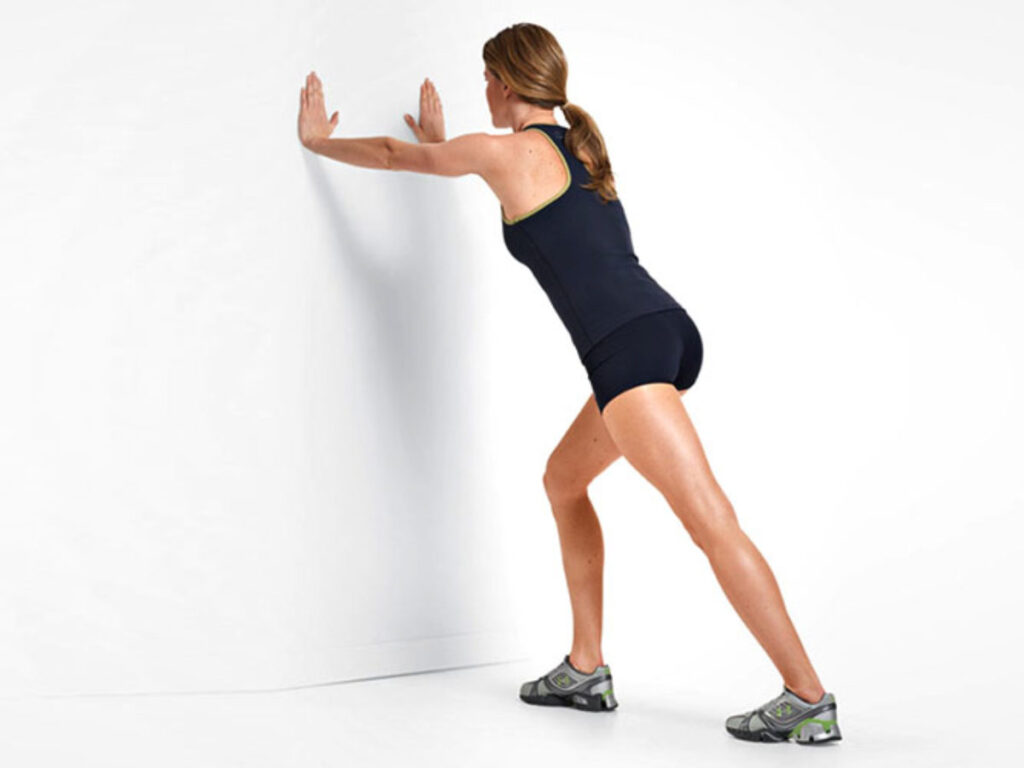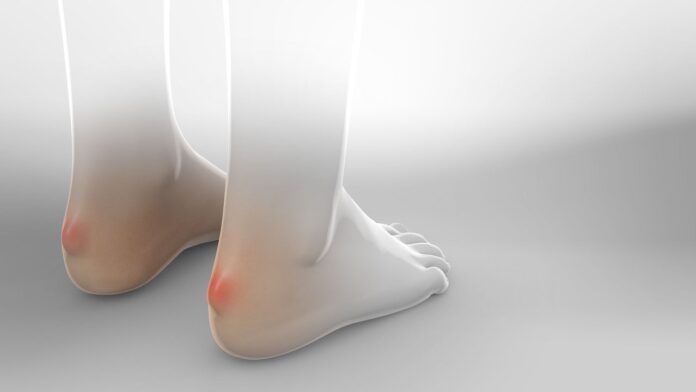Haglund’s deformity, also known as pump bump or retrocalcaneal bursitis, is a common condition where a bony enlargement on the back of the heel leads to irritation and inflammation in the surrounding soft tissues, including the Achilles tendon. This often painful condition can cause difficulty with wearing shoes, walking, running and other activities. While severe cases may require surgery, many people can manage Haglund’s deformity through conservative treatments like orthotics, pads, anti-inflammatory medications, stretching, rest, ice and exercises to strengthen and stretch the calf muscles and Achilles tendon.
Understanding Haglund’s Deformity

Haglund’s deformity refers to a prominence or bump on the back of the heel bone (calcaneus) near where the Achilles tendon attaches. This bony protrusion leads to irritation and inflammation of the bursa (fluid-filled sac) located between the Achilles tendon and the heel bone.
Key features of Haglund’s deformity include:
- Bony Protrusion: An enlarged section of the calcaneus rubs against shoes, causing pain and irritation. This bump is often mistaken for an Achilles tendon knot or calf muscle knot.
- Achilles Tendon Irritation: The inflamed bursa and enlarged bone irritate the Achilles tendon where it attaches to the calcaneus. This can cause thickening and painful swelling of the tendon.
- Bursitis: Inflammation of the bursa between the Achilles tendon and heel bone, called retrocalcaneal bursitis. This causes pain in the back of the heel.
- Difficulty Wearing Shoes: Rigid backs and heels on shoes rub against the enlarged bony protrusion, aggravating symptoms.
Haglund’s deformity is common in athletes (especially runners), dancers or those who wear rigid, poorly fitting shoes. The condition usually develops slowly over time. Early treatment is important to avoid progression and more serious complications like tendon rupture.
Goals of Exercise for Haglund’s Deformity

Certain exercises can help manage Haglund’s deformity pain, stretch and strengthen the Achilles tendon and calf muscles impacted by the condition, and prevent loss of flexibility that could worsen symptoms.
Key exercise goals include:
- Stretch and Lengthen the Achilles Tendon: Tightness in the Achilles tendon increases tension at the back of the heel, putting extra stress on the already irritated tissues. Stretches gently lengthen this tendon.
- Strengthen the Calf Muscles: Strong and flexible calf muscles help support the ankle and take pressure off the inflamed area near the heel bone. They also aid shock absorption in the foot.
- Improve Ankle and Foot Flexibility: Exercises that mobilize the ankle and foot promote flexibility in this area, reducing strain on the Achilles tendon and helping prevent future bony protrusions.
- Reduce Pain and Swelling: Along with medication and rest, certain exercises can aid circulation to improve healing and help relieve pain from Haglund’s deformity.
- Protect the Heel: Building strength in the lower leg also gives added support and stability to the ankle and heel, protecting this sensitive area from re-injury.
When starting an exercise program, it’s crucial to begin slowly and carefully progress at a pace that does not worsen symptoms. Low-impact activities are best at first. Stop any exercise that causes new or worsening pain. As you heal, gradually increase intensity.
Helpful Stretches, Strengthening Exercises and More

The following exercises target the calf muscles, Achilles tendon, ankles, and feet to aid recovery from Haglund’s deformity. Perform them gently and pay attention to alignment to prevent future foot or ankle imbalances.
Calf Stretches
Tight calf muscles contribute to Achilles tendon irritation and ankle/foot issues, so maintaining calf flexibility is key. Hold the following stretches 30-60 seconds on each side, 2-3 times daily:
Runner’s Stretch
- Stand facing a wall slightly more than arm’s length away
- Place one leg forward bent at the knee, foot flat on floor
- Straighten back leg with toes pointed forward, heel on floor
- Keeping back leg straight and hips square, gently lean hips toward wall until stretch is felt in calf
- Switch legs and repeat
Downward Facing Dog Pose
From all fours position:
- Curl toes under and gently straighten legs to lift hips up and back to form an inverted V shape
- Allow heels to stretch downward to floor as calf muscles relax
- Hold then gently bend knees to release if needed
Seated Soleus Stretch
- Sit on floor with legs straight out in front
- Loop a towel, rope or strap around the ball of one foot
- Gently pull back on towel flexing foot as calf stretches
- Keep knee straight and repeat on other side
Achilles Tendon Stretches
Gentle stretches keep the Achilles tendon flexible, preventing excessive pull on the irritated retrocalcaneal region. Repeat 2-3 times daily:
Standing Calf Stretch
- Stand facing wall with hands on wall at eye level
- Step one leg back with knee straight and heel on floor
- Bend front knee slowly over front foot feeling stretch in back calf and Achilles tendon
- Switch legs and repeat
Eccentric Heel Drop
- Stand with balls of feet on stair or block, heels extending off
- Slowly lift onto toes then lower heels beneath step in a controlled motion
- Return to start and repeat
Seated Achilles Stretch
- Sit on floor with one leg bent, foot flat on floor
- Extend other leg out straight
- Wrap a towel around ball of foot and gently pull back flexing foot until stretch is felt in the calf muscle and Achilles
- Keep knee straight and repeat on other side
Strengthening Exercises
In addition to stretching tight tissues, strengthening exercises promote proper mechanics and take stress off inflamed areas. Work up to higher reps slowly.
Calf Raises
- Stand with feet hip width, holding wall for support
- Raise up slowly onto balls of feet then lower controlled
- Repeat 15-30 times
Single-leg Calf Raises
More advanced:
- Stand on one leg, heels raised, unsupported
- Lower down slowly then raise back up onto ball of foot
- Keep hips level and repeat 10-15 times per side
Towel Grab and Release
- Sit on floor with legs straight
- Place towel on floor under feet
- Curl toes under to grab towel then straighten toes to release
- Repeat curls and releases 15 times
Foot Doming
- Sit with leg extended
- Activate calf/foot muscles to “dome” top of foot upward without curling toes
- Hold 3 seconds then release, repeat 10 times
Banded Ankle Exercises
- Sit with stretch band looped around ball of foot
- Point foot away then pull foot inward against band
- Flip band to work foot inward then outward
- Repeat sets of 15 pointing foot with resistance
Low-Impact Cardio
Low-impact cardio exercise enhances blood flow and healing without jarring sensitive tissues. Try:
- Walking
- Pool exercises like water walking or swimming
- Stationary cycling
Be sure to wear proper footwear with adequate cushioning and avoid hills or uneven terrain that could aggravate the heel.
Recovery Recommendations
Along with the above stretches and exercises, be sure to incorporate rest, ice, compression, and medication as recommended by your podiatrist or orthopedist. Some guidelines include:
- Apply ice for 15 minutes after activity to control pain and inflammation
- Wear a heel lift, pad or orthotic to take pressure off the enlarged bone
- Take over-the-counter pain relievers like acetaminophen or ibuprofen to relieve discomfort
- Limit activity that aggravates your symptoms like running or jumping until healed
- Resume activity gradually under your doctor’s supervision
- Consider working with a physical therapist to ensure proper progression
When to Seek Medical Treatment

Most cases of Haglund’s deformity can be managed conservatively with stretches, exercises, orthotics, and medications. However, see your doctor if you experience:
- Inability to walk or put weight on your foot due to pain
- Noticeable swelling in your heel or ankle that gets worse
- Redness, bruising or warmth around the back of your heel
- Numbness or tingling in the heel, ankle or calf
- No improvement in symptoms after 6 weeks of appropriate self-care
Sudden worsening of symptoms may indicate an Achilles tendon tear or rupture requiring prompt medical care to prevent complications. Seek emergency care for difficulty moving your ankle/foot, sudden weakness or instability in the area or loss of sensation.
Surgery may ultimately be necessary if conservative treatments fail to provide adequate relief over time or in long-standing cases. Discuss your exercise recovery progress at follow up appointments to determine if operative intervention makes sense given your particular case and lifestyle goals.
Outlook for Haglund’s Deformity with Exercise Treatment

The overall prognosis for Haglund’s deformity with a regimen focused on calf stretches and lower leg strengthening is quite good. According to research:
- Up to 90% of people with Haglund’s deformity improve with conservative treatment like orthotics and exercise therapy within 6 to 12 months
- Stretching calf muscles and Achilles tendon prevents worsening contractures that could require surgery
- Strengthening the ankle and foot stabilizers aids shock absorption to prevent re-injury
- Non-operative approaches prevent surgical complications like infection or nerve damage
Committing to lower leg flexibility and strength building, wearing orthotics religiously, limiting aggravating footwear, and being patient through gradual rehabilitation all set the stage for optimal recovery without invasive measures. However, some cases do require surgery if significant foot function impairment and deformity develops. Committing to post-surgical therapy and activity modifications prevents recurrence.
FAQs
It is generally recommended to stretch the calf muscles and Achilles tendon 2-3 times per day, especially before and after activity. Hold stretches for 30-60 seconds on each side for maximum benefit.
Helpful strengthening exercises include calf raises, single-leg calf raises, towel grabs/releases, foot doming, and banded ankle movements working both inversion and eversion range of motion.
Most patients begin experiencing at least some relief in pain and function within 6-12 weeks of focused stretching, strengthening, orthotic use, anti-inflammatory treatment, and activity modification. However, full recovery can take 6 months or longer.
Running is often possible but the impact may prolong healing if done too intensely too soon. It’s best to avoid running in the acute phase. As pain allows, start with short intervals of slow jogging on softer surfaces while wearing well-cushioned shoes. Slowly increase distance then consider racing again once fully rehabilitated.
Surgery may be necessary if conservative treatments like orthotics, activity modification, NSAIDs, ice, rest, and physical therapy provide no lasting relief after 6 months or if foot function becomes greatly impaired from ongoing deformity.
Conclusion
As a common cause of heel pain and limping, Haglund’s deformity often arises from biomechanical stressors over time – but gentle stretching and strengthening activities help realign the foot and ankle to prevent worsening damage. Low-impact cardio also aids recovery. Along with orthotics and anti-inflammatory care, a mindful self-care regimen focused on restoring mobility and stability to the Achilles tendon and calf region reduces irritation on the back of the heel and sets the stage for lasting relief. Paying attention to symptom triggers and avoiding re-injury during exercise is key during the healing process. However, surgical intervention may be warranted if conservative measures fail to adequately restore comfortable function. Committing to rehab and being patient with your body’s timelines makes all the difference in recovering from this notoriously nagging condition.


